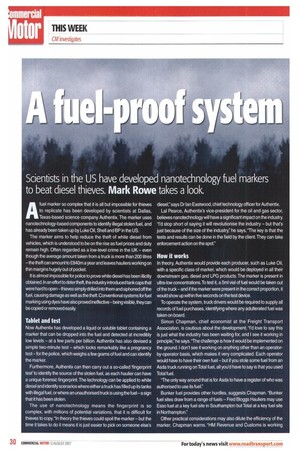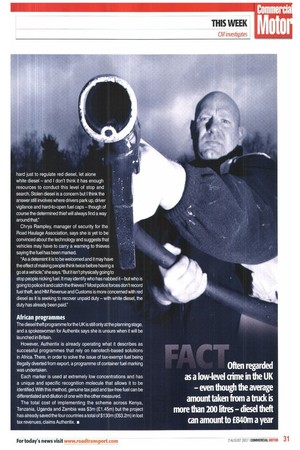uel-proof s
Page 30

Page 31

If you've noticed an error in this article please click here to report it so we can fix it.
Scientists in the US have developed nanotechnology fuel markers to beat diesel thieves. Mark Rowe takes a look.
Afuel marker so complex that it is all but impossible for thieves to replicate has been developed by scientists at Dallas, Texas-based science company Authentix. The marker uses nanotechnology-based components to identify illegal stolen fuel, and has already been taken up by Luke Oil, Shell and BP in the US.
The marker aims to help reduce the theft of white diesel from vehicles, which is understood to be on the rise as fuel prices and duty remain high Often regarded as a low-level crime in the UK — even though the average amount taken from a truck is more than 200 litres —the theft can amount to £840m a year and leaves hauliers working on thin margins hugely out of pocket.
It is almost impossible for police to prove white diesel has been illicitly obtained. In an effort to deter theft, the industry introduced tank caps that were hard to open —thieves simply drilled into them and siphoned off the fuel, causing damage as well as the theft Conventional systems for fuel marking using dyes have also proved ineffective—being visible, they can be copied or removed easily.
Tablet and test
Now Authentix has developed a liquid or soluble tablet containing a marker that can be dropped into the fuel and detected at incredibly low levels — at a few parts per billion Authentix has also devised a simple two-minute test — which looks remarkably like a pregnancy test — for the police, which weighs a few grams of fuel and can identify the marker.
Furthermore, Authentix can then carry out a so-called 'fingerprint test' to identify the source of the stolen fuel, as each haulier can have a unique forensic fingerprint The technology can be applied to white diesel and identify scenarios where either a truck has filled up its tanks with illegal fuel, or where an unauthorised truck is using the fuel —a sign that it has been stolen
The use of nanotechnology means the fingerprint is so complex, with millions of potential variations, that it is difficult for thieves to copy. -In theory the thieves could spoil the marker— but the time it takes to do it means it is just easier to pick on someone else's
diesel," says Dr Ian Eastwood, chief technology officer for Authentix Lal Pearce, Authentix's vice-president for the oil and gas sector, believes nanotechnology will have a significant impact on the industry. "I'd stop short of saying it will revolutionise the industry — but that's just because of the size of the industry," he says. "The key is that the tests and results can be done in the field by the client. They can take enforcement action on the spot"
How it works
In theory, Authentix would provide each producer. such as Luke Oil, with a specific class of marker, which would be deployed in all their downstream gas, diesel and LPG products. The marker is present in ultra-low concentrations. To test it, a 5m1vial of fuel would be taken out of the truck —and if the marker were present in the correct proportion, it would show up within five seconds on the test device To operate the system. truck drivers would be required to supply all records of fuel purchases, identifying where any adulterated fuel was taken on board Simon Chapman. chief economist at the Freight Transport Association, is cautious about the development. "I'd love to say this is just what the industry has been waiting for, and I see it working in principle: he says. "The challenge is how it would be implemented on the ground.] don't see it working on anything other than an operatorby-operator basis, which makes it very complicated. Each operator would have to have their own fuel — but if you stole some fuel from an Asda truck running on Total fuel, all you'd have to say is that you used Total fuel.
"The only way around that is for Asda to have a register of who was authorised to use its fuel."
Bunker fuel provides other hurdles. suggests Chapman. "Bunker fuel sites draw from a range of fuels — Fred Bloggs Hauliers may use Esso fuel at a key fuel site in Southampton but Total at a key fuel site in Northampton!'
Other practical considerations may also dilute the efficiency of the marker, Chapman warns "HM Revenue and Customs is working hard just to regulate red diesel, let alone white diesel — and I don't think it has enough resources to conduct this level of stop and search. Stolen diesel is a concern but I think the answer still involves where drivers park up, driver vigilance and hard-to-open fuel caps — though of course the determined thief will always find a way around that."
Chrys Rampley, manager of security for the Road Haulage Association, says she is yet to be convinced about the technology and suggests that vehicles may have to carry a warning to thieves saying the fuel has been marked.
As a deterrent it is to be welcomed and it may have the effect of making people think twice before having a go at a vehicle," she says:But it isn't physically going to stop people nicking fuel, It may identify who has nabbed it— but who is going to policed and catch the thieves? Most police forces don't record fuel theft, and HM Revenue and Customs is more concerned with red diesel as it is seeking to recover unpaid duty — with white diesel, the duty has already been paid:'
African programmes
The diesel theft programme for the UK is still only at the planning stage, and a spokeswoman for Authentix says she is unsure when it will be launched in Britain.
However, Authentix is already operating what it describes as successful programmes that rely on nanotech-based solutions in Africa. There, in order to solve the issue of tax-exempt fuel being illegally diverted from export, a programme of container fuel marking was undertaken.
Each marker is used at extremely low concentrations and has a unique and specific recognition molecule that allows it to be identified. With this method, genuine tax paid and tax-free fuel can be differentiated and dilution of one with the other measured.
The total cost of implementing the scheme across Kenya, Tanzania, Uganda and Zambia was $3m (21 45m) but the project has already saved the four countries a total of $130m (63.2m) in lost tax revenues, claims Authentix






























































































































































































